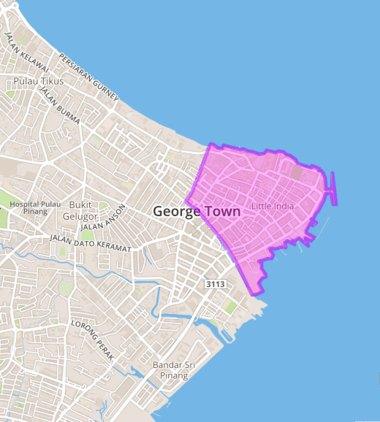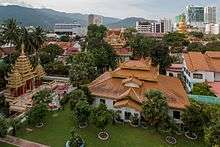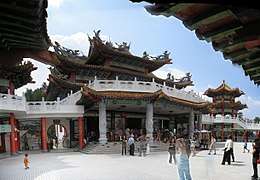Wat Chaiyamangkalaram
| Wat Chaiyamangkalaram | |
|---|---|
 | |
 Location within George Town | |
| Geography | |
| Coordinates | 5°25′53.7918″N 100°18′48.7902″E / 5.431608833°N 100.313552833°ECoordinates: 5°25′53.7918″N 100°18′48.7902″E / 5.431608833°N 100.313552833°E |
| Country | Malaysia |
| State | Penang |
| Locale | Pulau Tikus |
| Location | George Town |
| Culture | |
| Sanctum | Buddha |
| Major festivals | |
| Architecture | |
| Architecture | Thai |
| History | |
| Date built | 1845 |
Wat Chaiyamangkalaram is a Thai Buddhist temple at the Pulau Tikus suburb in George Town, Penang, Malaysia. Notably, the temple, situated directly across Burmah Lane from Dhammikarama Burmese Temple, contains one of the world's longest reclining Buddha statues, as well as several coloured statues of Devas and other mythical creatures.[1][2]
In addition, Wat Chaiyamangkalaram, surrounded by a small ethnic Siamese community, serves as a focal point for the annual Songkran and Loi Krathong celebrations in George Town.[1][3][4] The temple also takes part in the city's yearly Vesak Day procession.[5]
History

Wat Chaiyamangkalaram was built in 1845 on a piece of land granted to the Siamese community in George Town by Queen Victoria.[1][3][6] The land, a diplomatic gesture to promote trading ties between the British Empire and the Siamese Rattanakosin Kingdom, was presented by the then Governor of the Straits Settlements, William John Butterworth, to four female Siamese trustees.
The first monk in Wat Chaiyamangkalaram was Phorthan Kuat, a Theravada Buddhist monk from Siam also known as the 'Powerful Monk'.[1] According to urban legend, he was very fond of asam laksa; to this day, the famous local dish is still offered to his shrine by devotees.
A reclining Buddha statue, named Phra Chaiya Mongkol, was created in 1958 at a cost of M$100,000 (Malayan dollar).[7] A vihara was also constructed in 1970.[3]
Wat Chaiyamangkalaram was visited in 1962 by the then King of Thailand, Bhumibol Adulyadej, and Queen Sirikit.[3]
Description
The Phra Chaiya Mongkol reclining Buddha statue measures 33 m (108 ft) from end to end, making it the third longest reclining Buddha statue in the world.[1] The statue actually serves as a columbarium, in which the urns of the cremated are housed.
Several smaller statues of the Buddha in various poses, as well as the Devas, can also be found throughout the temple, particularly adorning the main prayer hall.
See also
References
- 1 2 3 4 5 Khoo, Salma Nasution (2007). Streets of George Town, Penang. Penang: Areca Books. ISBN 9789839886009.
- ↑ Das Gupta, Sameer (2008). Advanced history of Buddhism: monasteries and temples. Cyber Tech Publications.
- 1 2 3 4 "myPenang - Siamese Heritage Trail". mypenang.gov.my. Retrieved 2017-05-09.
- ↑ "The last Siamese village of Penang". The last Siamese village of Penang,. Retrieved 2017-05-09.
- ↑ "Volunteers help spruce up temples and prepare for grand float procession - Community | The Star Online". www.thestar.com.my. Retrieved 2017-05-10.
- ↑ Chuah, Jin Seng (2013). Penang 500 Early Postcards. Editions Didier Millet. ISBN 9789671061718.
- ↑ "Malaysia". www.trekearth.com. Retrieved 2017-05-16.


%2C_Sentul%2C_Kuala_Lumpur.jpg)
